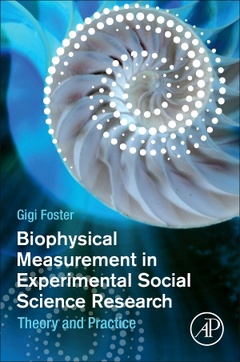Description
Biophysical Measurement in Experimental Social Science Research
Theory and Practice
Coordinator: Foster Gigi
Language: English
Subjects for Biophysical Measurement in Experimental Social Science...:
359 p. · 15x22.8 cm · Paperback
Description
/li>Contents
/li>Readership
/li>Biography
/li>Comment
/li>
Biophysical Measurement in Experimental Social Science Research is an ideal primer for the experimental social scientist wishing to update their knowledge and skillset in the area of laboratory-based biophysical measurement. Many behavioral laboratories across the globe have acquired increasingly sophisticated biophysical measurement equipment, sometimes for particular research projects or for financial or institutional reasons. Yet the expertise required to use this technology and integrate the measures it can generate on human subjects into successful social science research endeavors is often scarce and concentrated amongst a small minority of researchers. This book aims to open the door to wider and more productive use of biophysical measurement in laboratory-based experimental social science research. Suitable for doctoral students through to established researchers, the volume presents examples of the successful integration of biophysical measures into analyses of human behavior, discussions of the academic and practical limitations of laboratory-based biophysical measurement, and hands-on guidance about how different biophysical measurement devices are used. A foreword and concluding chapters comprehensively synthesize and compare biophysical measurement options, address academic, ethical and practical matters, and address the broader historical and scientific context. Research chapters demonstrate the academic potential of biophysical measurement ranging fully across galvanic skin response, heart rate monitoring, eye tracking and direct neurological measurements. An extended Appendix showcases specific examples of device adoption in experimental social science lab settings.
1. Eye Tracking as a Tool for Examining Cognitive Processes 2. Brain Morphometry for Economists: How do Brain Volume Constraints Affect Our Choices? 3. fMRI in Economics: What Functional Imaging of the Brain Can Add to Behavioral Economics Experiments 4. Skin Conductance in the Study of Politics and Communication 5. Steroid Hormones in Social Science Research 6. An Interoceptive Walk Down Wall Street 7. Mind, Body, Bubble! Psychological and Biophysical Dimensions of Behavior in Experimental Asset Markets 8. Opportunities and Challenges of Portable Biological, Social, and Behavioral Sensing Systems for the Social Sciences 9. Can Social Scientists Use Molecular Genetic Data to Explain Individual Differences and Inform Public Policy? 10. Conclusion
Appendix 1. Getting Started With Eye Tracking 2. Using Heart Rate Variability Measures in Social Science Research
Graduate and PhD students doing experimental research as part of their thesis or as part of a paper, particularly within experimental and behavioral economics, neuro-economics, cognitive psychology, and social psychology, and also possibly some experimental management and/or marketing. Established academics wishing to be brought up to speed on the latest measurement technology available in human behavior laboratories.
- Demonstrates the strengths and limitations of different tools, in terms of both research objectives and practicality
- Provides hands-on guidance for device usage and data integration and assessment
- Compares and contrasts the use of different biophysical data options for different research objectives and in different disciplines

